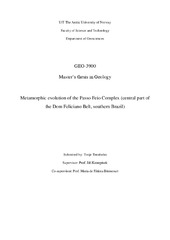| dc.contributor.advisor | Konopásek, Jiří | |
| dc.contributor.advisor | Bitencourt, Maria de Fátima | |
| dc.contributor.author | Tennholm, Tonje | |
| dc.date.accessioned | 2019-06-03T08:46:48Z | |
| dc.date.available | 2019-06-03T08:46:48Z | |
| dc.date.issued | 2019-05-15 | |
| dc.description.abstract | The Passo Feio Complex is considered as a part of the São Gabriel Terrane, located to the west of the Dom Feliciano Belt in the state of Rio Grande do Sul (Brazil), but shows numerous similarities with the easterly exposed Porongos Metamorphic Complex which is a part of the Schist Belt in that area. P-T phase equilibrium modelling of metamorphosed sedimentary rocks from the Passo Feio Complex was performed with an aim to compare thermal conditions during their metamorphic evolution with those of the Porongos Metamorphic Complex and other related parts of the Dom Feliciano Belt foreland during orogenesis.
Petrographic and field observations of metapelitic samples suggest that the southern part of the complex can be subdivided into three metamorphic zones: one zone corresponding to greenschist facies conditions and two zones corresponding to lower and middle amphibolite facies conditions, respectively. Phase equilibrium modelling of samples from the southeastern (staurolite- and garnet-bearing) zone suggests that garnet started to crystallize at ca. 515-555°C and 2.7-4.8 kbar. Estimated peak metamorphic conditions suggest temperatures of ca. 535-590°C and pressures of ca. 4.7-7.6 kbar. Assuming an average crust density of 2.8 g/ cm3, these conditions suggest an apparent thermal gradient of ca. 35-55°C/km during the onset of garnet growth, and 19-35°C/km for the equilibration of garnet rims and the matrix mineral assemblage. Phase equilibrium modelling of one sample from the southern zone (garnet-bearing) zone suggests that garnet started to crystallize at ca. 485°C and 2.6 kbar, and that peak metamorphic conditions were reached at temperatures of ca. 500-550°C and pressures of ca. 5.3-7.0 kbar. These conditions suggest an apparent thermal gradient of ca. 50°C/km for the onset of garnet growth and a decrease to ca. 20-29°C/km during peak metamorphic conditions. The rocks were thrust down to depths of ca. 17-28 km with a decrease in the apparent thermal gradient towards the equilibration of the matrix mineral assemblage. Contact metamorphism is evident close to the ca. 560 Ma Caçapava Granite, indicating that a local thermal event (M2) occurred after the complex reached its peak metamorphic conditions.The modelling results are similar to those from the easterly exposed Porongos Metamorphic Complex, suggesting that the protolith rocks of the Passo Feio Complex could have originally represented the same rift basin that was inverted during the formation of the Dom Feliciano Belt in the state of Rio Grande do Sul in the time interval between ca. 650 and 560 Ma. | en_US |
| dc.identifier.uri | https://hdl.handle.net/10037/15414 | |
| dc.language.iso | eng | en_US |
| dc.publisher | UiT Norges arktiske universitet | en_US |
| dc.publisher | UiT The Arctic University of Norway | en_US |
| dc.rights.accessRights | openAccess | en_US |
| dc.rights.holder | Copyright 2019 The Author(s) | |
| dc.rights.uri | https://creativecommons.org/licenses/by-nc-sa/4.0 | en_US |
| dc.rights | Attribution-NonCommercial-ShareAlike 4.0 International (CC BY-NC-SA 4.0) | en_US |
| dc.subject.courseID | GEO-3900 | |
| dc.subject | Passo Feio Complex | en_US |
| dc.subject | Dom Feliciano Belt | en_US |
| dc.subject | Volcano-sedimentary basin | en_US |
| dc.subject | Metasedimentary rocks | en_US |
| dc.subject | VDP::Mathematics and natural science: 400::Geosciences: 450 | en_US |
| dc.subject | VDP::Matematikk og Naturvitenskap: 400::Geofag: 450 | en_US |
| dc.title | Metamorphic evolution of the Passo Feio Complex (central part of the Dom Feliciano Belt, southern Brazil) | en_US |
| dc.type | Master thesis | en_US |
| dc.type | Mastergradsoppgave | en_US |


 English
English norsk
norsk

